I stumble forward on the black, frozen scree and squint at the rising sun. I’m on the edge of a mammoth crater and unsteadily following its jagged rim.
I’m exhausted. My two African guides gently coerce me forward while my brothers, who walk unassisted, coax me with the uninspiring ‘you’re a bad ass!’ I stop and the blood and snot is wiped from my tender, grubby nose while my own hands hang at my side listlessly, my fingers numb from the icy wind. A cup of tea is pushed towards my lips, but I turn my head away like a child. My teary eyes glance with emptiness at the blue chasms of glacier on my left as I’m pushed on. I’m wearing five pairs of pants, four tops, two jackets, two beanies and a headache the size of a mountain.
We reach a disorganised mass of people huddled around a wooden sign and stop. I sway as though drunk. We are motioned by one of our guides and I slump down next to my brothers and grimace at the camera before being shooed away by impossibly eager tourists. I’ve done it. I’ve climbed Mount Kilimanjaro. And I couldn’t care less.
I walk a few steps back, dry wretch three times and vomit a teaspoon’s worth of dark yellow bile while a porter pats me gently on my back and awkwardly, my front. I think maybe I should have had some tea.
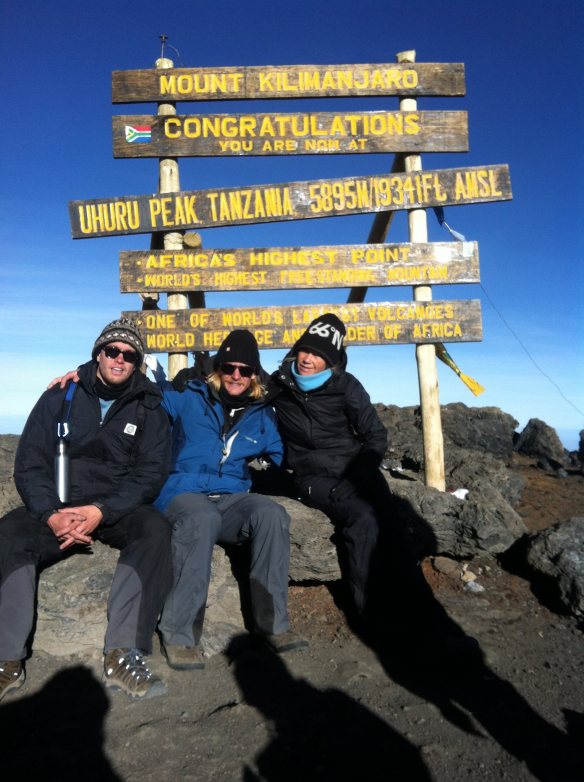
*
Since the first officially-recorded climb of Mount Kilimanjaro in 1889 by German geologist, Hans Meyer, hundreds of thousands of people have climbed this ‘roof’ of Africa. I am officially the 384,585th person to reach its top point, Uhuru Peak, presumably since the National Park mandated climber registration in 1991, but no one can – or will – confirm this detail. Bodil Ashton, from the Kilimanjaro Mountain Club, the organisation that used to manage the mountain, tells me that ever since the government took over in 1973, access to information has been difficult. Her tired frustration is evident; now the Club just collates archives. In any case, this number doesn’t include the army of locals supporting our bourgeois expeditions, nor the poor adventurers who don’t quite make it due to altitude sickness. Nor the people who climbed when ascents were simply announced in newspapers, nor all those who bribe their way up today. Numbers are vague, but around 35,000 tourists attempt to climb Mount Kilimanjaro every year and anywhere between 45-85% reach the final summit, depending on the route they take.
*
30 September, 2016: Day 1
Moshi Town (915m) to Mkubwa Campsite (2,250m)
On the way to the registration gate, we stop and I buy myself a pair of $15, rose-tinted Roy Bins. As the jeep traverses the long highway, I chuckle to myself as I gaze out the window through these ironically-coloured glasses; the arid farmlands and shanty towns of rural Tanzania are so beautiful in this dusky tinge. This keeps my mind far from the looming mountain we are on our way to climb.
I’m on this tour with my two younger brothers, Evan and Liam, and a smiling Californian called Chris. We are sharing this part of the journey with a pair of Norwegians on their own tour, Alvhild and Ragnhild, who buy disposable razors last minute and are already ruing the lack of showers.
We begin the walk without fanfare. Ali, our guide, leads us, while Cypi, our assistant guide, keeps pace at the back. The porters run on ahead with our gear resting on their heads and necks. We walk slower than I’ve ever walked before. In Swahili, they call it pole pole.
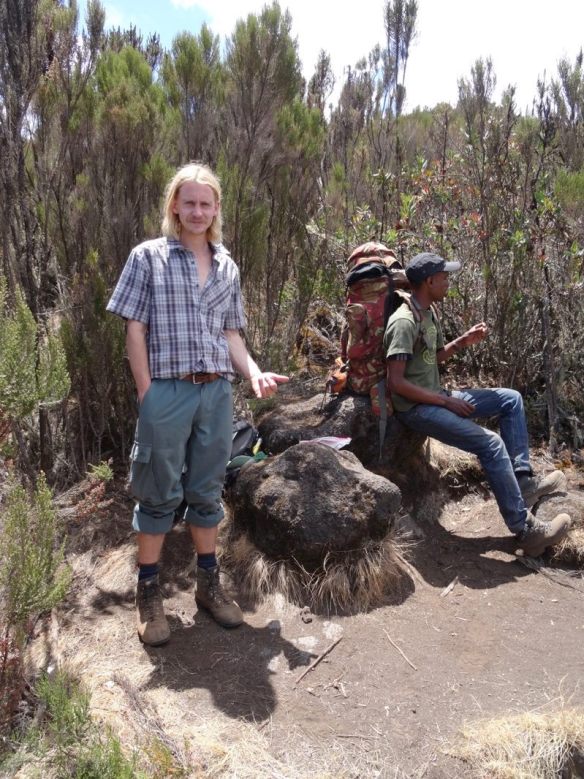
Four hours later, we reach our busy jungle campsite. Besides a range of other tour groups, we are surrounded by blue monkeys grasping for mouldy bread that’s dangled by teasing, cheeky porters.
We watch the porters organise our tents, which they construct haphazardly upon tree roots, amidst ant nests, without tension. Cypi starts brushing the dust off our feet and trousers. We are horrified at the subservience, but our attempts to stop him are met with annoyance; this is his job. Omari, our waiter, brings ‘water for wash’; each of us is given a small tub of hot water and Ali tells us we’ll enjoy this ritual every morning and night. He then points out our dining tent and says that we’ll have tea and popcorn every afternoon. We look at each other, embarrassed at this seeming colonial reality, and retreat to our tents to make our beds.
The porters are wearing a mishmash of donated outdoor wear with faded logos, strange western-branded t-shirts and well-loved soccer jerseys. One porter wears a Baker’s Delight hoody. I’m reminded of the story of a porter freezing to death earlier in the week; a hoody is no protection from the cold.

*
There’s a lot of controversy over working conditions for porters in the mountain tourism industry. In Tanzania, the non-governmental organisation, Kilimanjaro Porters Assistance Project, established in 2003, works to address these concerns. They provide proper gear, free classes in English and First Aid, and attempt to ensure that their partner companies meet the guidelines regarding fair wages, load weights, tipping and daily provisions. Our self-named ‘charitable’ operator, Zara Tours, is not a current partner and established its own Mount Kilimanjaro Porters Society in 2006. Although they claim to offer similar support, this fact alone suggests discord in the industry. I can’t help but be cynical, especially when we never counted the recommended three porters per climber on our own tour. Did our porters carry more than the 20kg limit? Was our tipping money fairly distributed? Ali dismissed my concerns when I asked, but I could see that it wasn’t so simple. Ali was lucky to come from a wealthy family who paid for his tourism degree. Most guides, like Cypi, start as porters. The hierarchy is clear.
*
1 October, 2016: Day 2
Mkubwa Camp (2,250m) to Shira Camp I (3,500m)
Today is a difficult day: 1000m of elevation and a steep, rocky incline. I’m told it’s the worst before the summit climb, but we’re feeling confident because it is a manageable struggle. But the dust is insidious. We inhale it as it’s kicked up by our slow-moving feet.
We share snacks as we walk. We give Ali and Cypi chocolate; they give us peanuts. Chris gives us all Twizzlers and we relish in the sweet, sour, chemical sensation.
We arrive at the campsite – now a low-alpine moorland zone – just as the wind picks up. The dust penetrates every surface. Our dining table has a thick film of ochre.
This campsite is patrolled by huge ravens with hooked beaks, which reminds me of Poe and makes me wonder if I’ll die on this mountain. But the curious population of doves, who potter around as though in Sydney suburbia, give me an odd sense of security.
The Norwegians are starting to relax. Covered in dust, Alvhild remarks, ‘I look like a Mexican!’, before grinning that she doesn’t think she’ll be shaving her legs this trip.
We learn of an American wedding party climbing the mountain. They have a Tanzanian pastor and lawyer, whom we pass three times on the trail earlier in the day. We wonder if they’ll make it. They’re planning to summit and conduct their record-breaking ceremony in daylight hours. I ask Ali why we can’t summit during the day. He laughs nervously and says, ‘I don’t want to see where I’m going.’ He pauses. ‘If I look up, I won’t want to continue.’ Ali has climbed the mountain over 250 times and is still intimidated by the peak. I blink away thoughts of anxiety.
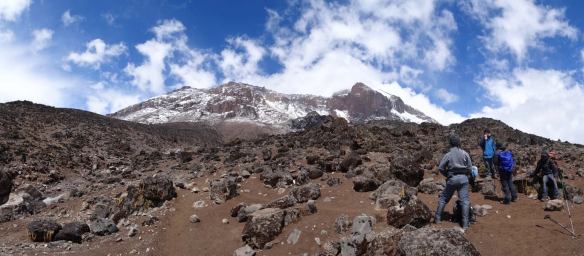
*
Big mountains make people want to do big things.
Statistics are constantly being updated for the oldest or fastest male and female climber, youngest boy and girl, climbers in wheelchairs, climbers without limbs, charity climbers.
Last year, Ecuadorian Karl Egloff reached the summit and back in a record 6 hours and 42 minutes. I barely made 1,200m in the same time.
In May of this year, Pizza Hut organised an unusual marketing stunt by having pizzas made in the capital, Dar Es Salaam, flown to Kilimanjaro airport and then walked to the summit in a battery-heated pack. The company’s General Manager and his employees enjoyed the pizzas at the top. I couldn’t eat anything for ten hours after descent, let alone a pizza on the peak.
*
2 October 2016: Day 3
Shira Camp I (3,500m) to Shira Camp II (3,840m)
Our walk is short and easy, giving us plenty of time to talk.
Ali tells us of the rivalry between Tanzania and Burundi: a respectful, light-hearted one similar to that between Australia and New Zealand. He tells us that all Tanzanians can tell a Burundi by asking them to count. At number four, nne, Burundi people pronounce it enne. Cypi, who barely speaks English, recognises the story and starts to laugh. We tell them about the Kiwi pronunciation of the number six. I ask if one of our porters is Burundi, and Ali says, ‘No. Burundis are tall, tough and very black. With very white teeth.’ He smiles and laughs his husky, open-mouthed laugh and I wonder how much whiter teeth could possibly be.
Chris, who’s 22 and fresh out of college, is impressed with our worldly lives; Liam is currently studying in Denmark, Evan is up to his 70th-odd country and this is my second time in Tanzania. Chris was inspired to come because his grandfather was born here, back when it was Tanganyika. He throws around his ambitions to travel the world and climb the big seven, but in the next breath says that when he gets home, he will buy a truck and settle down. He doesn’t understand how we can travel so much and I tell him it’s all about the choices we make. He agrees but I can see that he doesn’t quite understand; he’s following his American Dream.
The rain starts. We play cards all afternoon in our dining tent, while our poorly constructed tents collect puddles of water. My sleeping bag is wet. I’m furious and think nothing of the mountain.
*
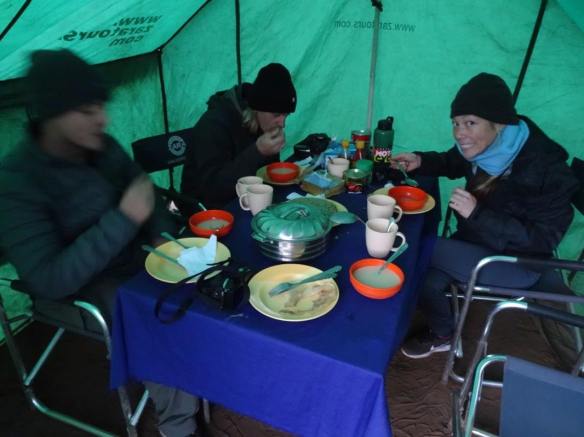
Americans are the number one nationality to climb Mount Kilimanjaro, despite Africa being the continent by far least travelled by passport-holding Americans, and Americans in general being much less likely than Australians to travel overseas at all. Many who travel there have a box to tick, and when one is planning to do the seven summits, Kilimanjaro is the easiest one to start with (unless you live in Australia, where you can go for a scenic drive and short bush walk and tick Mount Kosciuszko, at a mere 2,228m, off your list). Australian climbers come in at fifth on the nationality list.
*
3 October 2016: Day 4
Shira Camp II (3,840m) to Barranco Camp (3,900m)
We hike through sparse alpine desert to Lava Point, a mighty 4,630m above sea level – a record for all of us. Here we stop for lunch, but none of us can eat. We slump down in our chairs feeling feverish and doze off as the crowds move around outside our tent. Ali stands over us like a parent, putting food on our plates and commanding: ‘You must eat for energy.’ We take a few bites. Liam vomits.
Several hours of slow walking follow. Liam vomits five times. We descend to our bustling mountain-side campsite with miserable relief. There are no flat surfaces anymore; we have to climb a hill in exasperated breath just to go to the toilet.
We chat with the Norwegians. Alvhild has decided to return to Moshi. She has been hallucinating, shivering wildly in the corner of her tent. She doesn’t want to risk anything; she has children at home. They both do. My brothers and I are our mother’s only children, and suddenly I think of how she might have been feeling as we embarked on this risky adventure together. What if the plane had gone down? What if there was some freak snowstorm that wiped us all out? What if we all died from altitude sickness?
Liam isn’t sure if he wants to go on. Evan thinks he’s dying. We all have headaches. We collapse into our beds after our long day.
*
Most of the estimated 7-10 tourists and porters who die each year on the mountain do so from altitude sickness. Most climbers will suffer from some symptom – vomiting and headaches – but taking a longer route, like our 8-day Lemosho trek, gives the body time to gradually acclimatise, which minimises any serious problems. No one knows why some people are more susceptible than others, but one scientific theory is it’s genetic.
There’s a lot of blame thrown around when people die on the mountain. While Alvhild was very adamant in her decision, her guide was unsupportive and reluctant to descend. If the rumours about the guides competing to reach the summit are true, then a less assertive person might not be able to stand up for themselves. Moreover, some people are so driven to reach the summit that they ignore their own body. On summit afternoon, we watched at least five stretchers rush past us in urgency, including one carrying the wedding pastor.
*
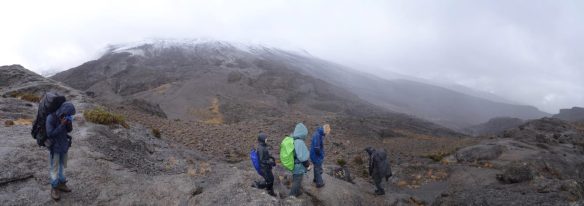
4 October 2016: Day 5
Barranco Camp (3,900m) to Karanga Camp (4,200)
It rains all day and our five hours of walking are a sad mixture of glory and pain. The scenery, we know, is spectacular, but we can’t see it through the fog. We scramble up Barranco wall and slip on slippery edges. Liam vomits seven times. Water permeates all surfaces. By the time we reach the campsite, everyone except me is drenched. I am quietly content, but feel guilty that my gear is reliable.
After dinner, the rain finally stops and the clouds above us clear to reveal the magnificent beast. The clouds below dissolve into the city lights of Moshi. We feel on top of the world.
The campsite buzzes and it’s not because of the raven sentinels; several trails have converged at this point. There’s a mix of languages, many new faces and the hum of music from cheap radios.
Liam is feeling better and my headache has disappeared. Evan and Chris spend the evening experimenting with their camera settings; the mountain is their star.

*
A group of academics at Bangor University in Wales recently concluded that while skydivers are ‘sensation seeking’, mountaineers are motivated by ‘emotion regulation and agency.’ This means that these sort of people tend to climb mountains because it’s the only activity where they can control their emotional and psychological response to their environment. They tend to feel almost no control in their day-to-day life and compensate with high-risk, endurance sports. While climbing Mount Kilimanjaro doesn’t require any technical skills, it’s certainly a physical, emotional and mental challenge. I wonder if that’s really who I am, and then I remember that besides this being my second mountain climb, I used to ride motorbikes really fast around race tracks for fun.
*
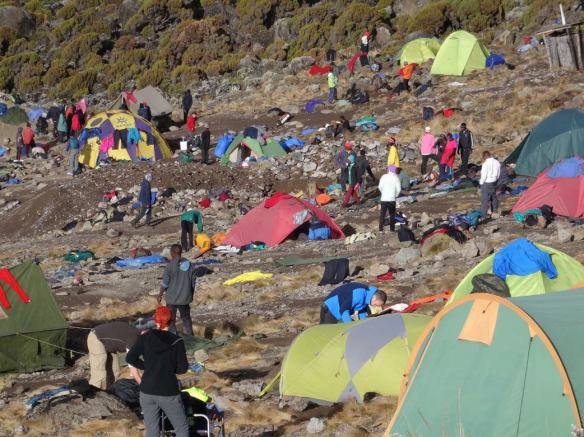 5 October 2016: Day 6
5 October 2016: Day 6
Karanga Camp (4,200) to Barafu Camp (4,550m)
The sunshine is invigorating. We throw our damp gear across rocks and relax late into the morning.
Our short walk takes us to the eastern side of the mountain across a vast, rocky, grey alpine desert. This new perspective is daunting, but I feel so close now to its beauty. On the way we see Ragnhild, who has been powering along the trail with just her guide for company. She tells us that Alvhild has been sitting by the hotel pool.
A distant yammering inches closer and I realise they’re female porters. Ali tells me that women are becoming more involved in the mountain. I smile with admiration at their strength and stamina.
We reach base camp just after midday. It’s an exposed rocky crag with different levels and tents tucked in between rocks. Our site is the highest. Below are the toilets and other groups; above is only the mountain. Everyone is feeling good. We eat bowls of rice, drink ginger tea and sleep early. Ali says his usual lala salama, which is Swahili for ‘sleep peacefully’. Suddenly it has so much more meaning.

*
George Mallory’s trite and somewhat flippant justification for climbing mountains is surprisingly accurate; there is no good reason to climb a mountain other than ‘because it’s there.’ And when I think back to the origins of my trip, all I can remember is my own flippant remark on hearing my brothers tell me their plan: ‘I’ll come!’ I never once reviewed this casual decision, not once in the ten months that followed. When Evan sent me invoices for various parts, I just paid them. I didn’t watch the videos he sent me about the trek and I barely even browsed the tour operator’s website. Although I am generally fit, a month before the trip I stopped exercising due to injury and only went on one long bushwalk three weeks before departure. It wasn’t until the summit trek that I thought, ‘What the hell am I doing?’ By then it was a little late and in the tragedy of my life, hubris came into play: I did not come all the way to Tanzania to fail. What would people think?
*
5-6 October, 2016: Day 7
Barafu Camp (4,550m) to Uhuru Peak (5895m)
We wake easily to our alarms. I’m grateful I’ve slept a few hours. I’m also anxious, but I put it out of my mind as I layer my clothes. We drink hot tea, eat sugary biscuits and start walking at 11:45pm. There’s excitement in the frosty air.
Pole pole.
One hour in and I have a dry throat and mouth. Then it’s all downhill.
No words can truly describe the agony of the next five hours, but I’m disoriented and yet at times deeply focused. I’m looking up in whimsy, dazzled by lights, wondering where the head-torches end and the stars begin. At some point, I decide that going down is worse than continuing up.
I’m reminded of my struggles exactly a year earlier when I climbed the diminutive Acatenango in Guatemala.
Ali and Cypi sing and make animal noises to keep me conscious. My brothers call out encouraging mantras. Cypi takes Chris up ahead. Ali fixes my clothes. He feeds me water. It freezes in our bottles.
As the sun starts to rise, we reach the first peak, Stella Point, where Chris and Cypi wait smiling. We run into a dazed Ragnhild. I sink, sip some tea, and over the next blurry hour, trudge between tears to the real summit, Uhuru Peak.

*
I am not the first to write about climbing Mount Kilimanjaro and I certainly won’t be the last, but it’s one of those extraordinary experiences that simply grips you with its (diminishing) ice-capped claws.
Travel writer, Tim Moore, calls the climb ‘the most appalling voluntary activity one could undertake in peacetime, the worst thing anyone … could ever pay to do.’ An old 1940s brochure calls it an ‘assault.’ Hyperbolic? Maybe, but that’s how I felt and that’s how I still feel as the mountain disappears into my memory like its evasive peak into the clouds, hidden and preserved. And although I don’t feel any sense of achievement, I do feel transformed. I couldn’t have done it without Ali, and probably not without my brothers. I will never do it again.
Next year my brothers want to go off-country skiing in Gulmarg, India, where the gondola – one of the highest in the world – lifts you to a lofty 4000m. I’m not a skier, but I haven’t said no.
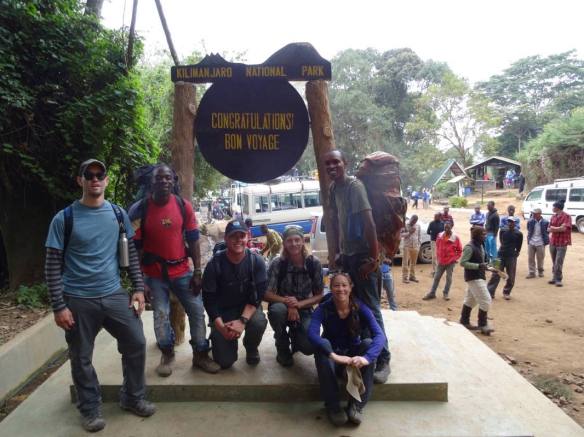
All photos except the summit sign are my bro’s – Evan Ford.
